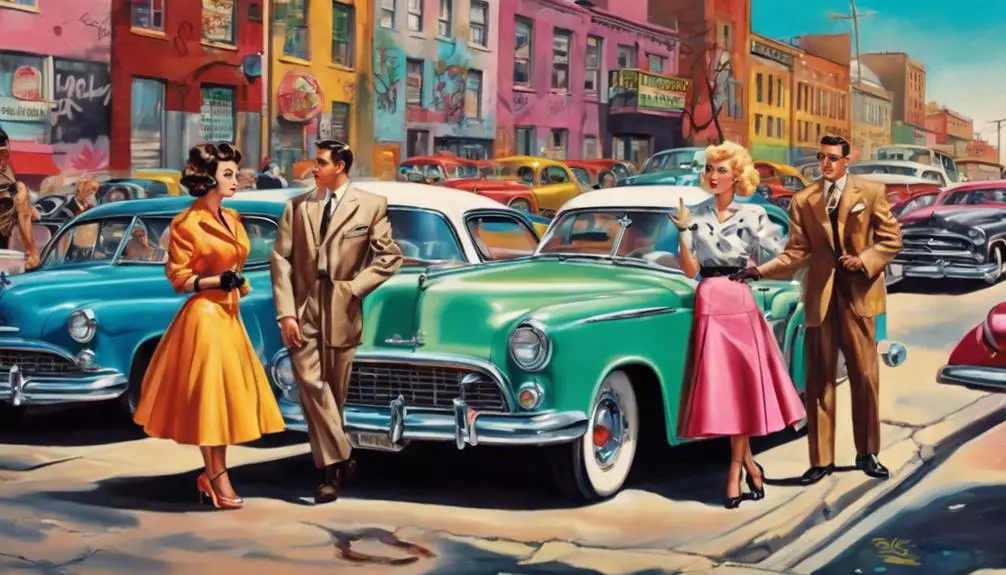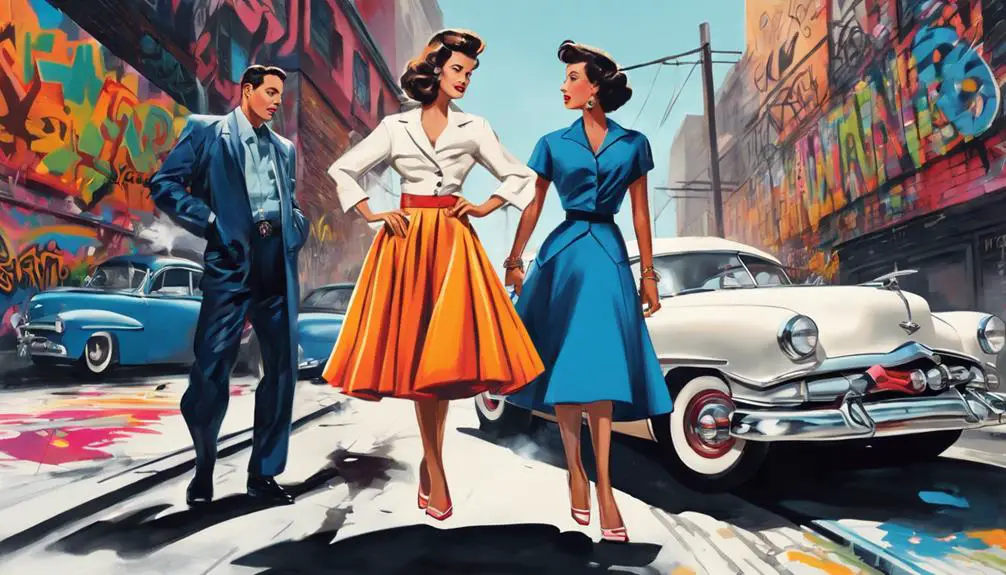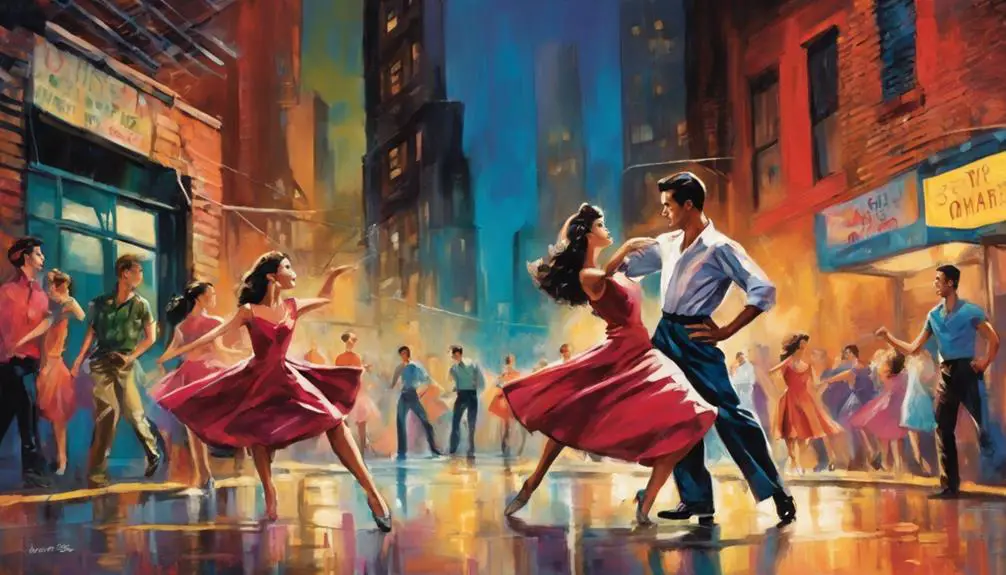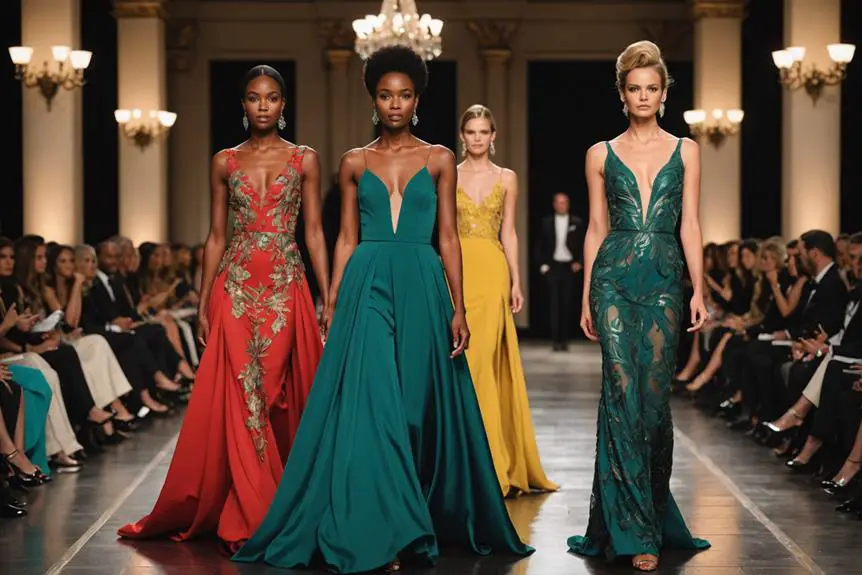Like a canvas painted with the vibrant hues of 1950s New York, the outfits in *West Side Story* serve as more than mere clothing; they embody the cultural tensions and aspirations of the time. You might notice how each character's wardrobe speaks volumes about their identity and social standing. Consider Maria's striking red dress or Anita's bold yellow ensemble—each piece is carefully designed to reflect their journeys. But what do these choices reveal about the intersection of fashion and narrative in this iconic film? Let's explore how costume design shapes our understanding of the characters and their world.
Historical Context of Costumes

In the late 1950s, the costumes in Spielberg's 2021 adaptation of *West Side Story* reflect a rich historical context that's essential for understanding the characters' identities. Costume designer Paul Tazewell meticulously researched real gangs from that era in New York City, ensuring that each outfit speaks volumes about the characters' backgrounds and aspirations. You'll notice how Tazewell established distinct color palettes for the Jets and the Sharks—these colors not only highlight their socio-economic differences but also capture their dreams and struggles.
Tazewell's work is heavily influenced by historical photographs from iconic photographers like Bruce Davidson and Gordon Parks, which helped him create an authentic visual narrative that resonates with audiences today. By grounding the costume design in the era's historical context, Tazewell allows you to immerse yourself in the cultural dynamics between the European descent groups and Puerto Rican immigrants depicted in the film.
The influence of the original production's costumes by Irene Sharaff can't be overlooked, either. Tazewell set out to honor that high standard while blending historical accuracy with modern interpretations, resulting in a fresh yet familiar look. Every detail, from the fabric choices to the overall silhouettes, reflects a thoughtful approach to storytelling through costumes. As you watch the film, appreciate how these costumes not only adorn the characters but also enrich your understanding of their struggles, aspirations, and identities, capturing the essence of a transformative time in American history.
Costume Design and Techniques
Costume design in Spielberg's *West Side Story* goes beyond aesthetic appeal; it serves as a powerful storytelling tool. Paul Tazewell, the talented costume designer, took a research-driven approach to craft authentic outfits that reflect the rich historical context of the time. By drawing inspiration from 20th-century photographers, he infused the film with a sense of realism that immerses you in the era.
One of Tazewell's standout techniques was establishing distinct color palettes for the Jets and Sharks. The Jets' cooler shades contrast sharply with the warm tones of the Sharks, visually representing their cultural identities and socio-economic backgrounds. This clever use of color isn't just for show; it enhances your understanding of the characters' motivations and conflicts.
Collaboration was key in the design process. Tazewell worked closely with cast members and the choreographer to guarantee that the costumes allowed for fluid movement during dynamic dance sequences. Custom techniques like petticoat designs and embroidered fabrics were employed to elevate the visual flow and emotional resonance of significant moments, such as Maria's iconic dress and Anita's vibrant costumes.
Tazewell's innovative approach emphasizes character-specific details and textures, contributing to a more naturalistic aesthetic that aligns beautifully with the narrative's themes of cultural conflict and identity. Overall, his meticulous costume design not only dazzles visually but also deepens your connection to the story and its characters, making the film a true visual feast.
Character Wardrobe Highlights

The wardrobe choices in *West Side Story* vividly illustrate each character's identity and emotional journey. Take Maria, for instance; her iconic red-belted lace dress is more than just a stunning piece of clothing. It symbolizes her innocence and deep connection to the Sharks while reflecting her transformation throughout the film. As she falls in love with Tony, her wardrobe mirrors her blossoming spirit, making her stand out against the gritty backdrop of 1950s New York.
Anita's vibrant yellow dress, showcased in the lively "America" scene, embodies joy and cultural pride. It's a bold statement that not only highlights her character's vivacious personality but also contrasts beautifully with the more subdued tones of her surroundings, enhancing the scene's celebratory atmosphere.
Then there's Tony, whose beige pants and navy jacket signify neutrality and hope. His outfit embodies his desire to bridge the divide between the Jets and the Sharks, showcasing the hope for unity amidst chaos.
Bernardo, wearing tailored outfits characterized by sharp lines and warm tones, reflects his leadership within the Sharks while honoring his cultural heritage. In contrast, the Jets flaunt punk-inspired attire, featuring denim and cooler shades, which perfectly captures their rebellious spirit and distinct identity.
Each of these wardrobe highlights not only adds depth to the characters but also enriches the narrative, making the film an unforgettable visual and emotional experience.
Thematic Color Significance
Color plays an essential role in *West Side Story*, shaping not just the visual experience but also the emotional undertones of the narrative. The distinct color palettes in the costumes serve as a powerful tool for expressing identity and emotion, allowing you to connect deeply with the characters. For the Jets, cooler shades dominate, evoking a sense of detachment and resilience, while the Sharks are adorned in warmer tones, bursting with cultural pride and hope for a brighter future.
Take Maria's stunning white dress with a red belt, for instance. It beautifully represents her innocence yet simultaneously ties her to the Sharks, highlighting her internal struggle and dual identity throughout the story. Similarly, Anita's bold black dress, accentuated with a red petticoat, vividly showcases her fiery spirit, creating a striking contrast against her surroundings and enhancing her passionate role in the unfolding drama.
These color choices do more than please the eye; they deepen your understanding of each character's socio-economic background and cultural heritage. By integrating color symbolism into the costumes, the designers effectively reinforce the themes of aspiration and identity, transforming fabric into a visual language that communicates complex emotions. So, as you immerse yourself in the world of *West Side Story*, pay attention to these vibrant hues; they're not just costumes but a vivid reflection of the characters' journeys, evoking a rich tapestry of emotions and identities.
Dance and Costume Integration

In *West Side Story*, dance and costumes intertwine seamlessly, elevating the storytelling to new heights. The 2021 adaptation showcases how costume designer Paul Tazewell collaborated with choreographer Justin Peck to create a vivid visual experience that complements the dynamic choreography. Each character's outfit not only enhances their movements but also reflects their emotional arc and social identity, making the performances even more engaging.
Take, for instance, the "America" sequence, where the vibrant costumes amplify the energy and cultural pride of the characters. The Sharks, dressed in warm tones, contrast beautifully with the Jets in cooler shades, reinforcing their rivalry while allowing for fluid movement. Tazewell's attention to detail guarantees that the costumes serve as an extension of the characters, allowing them to express their emotions through dance.
Maria's innocent white dress stands out, symbolizing hope and purity, while Anita's bold black dress radiates passion and empowerment. These choices deepen the narrative, making each character's journey more relatable and impactful. The custom costumes, designed with the 1950s New York historical context in mind, utilize textiles and patterns that resonate with the characters' backgrounds, further enriching the storytelling.
As you watch the film, pay attention to how the costumes not only enhance the choreography but also tell a story of their own. The integration of dance and costume creates a mesmerizing spectacle, making *West Side Story* a true masterpiece of visual and emotional artistry.
Cultural Representation in Fashion
Through vibrant color palettes and thoughtful design, the 2021 adaptation of *West Side Story* highlights the rich cultural representation of Latinx communities. Costume designer Paul Tazewell brilliantly captures the essence of cultural authenticity through his meticulous costume design, which showcases the diverse backgrounds and aspirations of the characters. The costumes distinguish the Jets and the Sharks not just by style, but by color and fabric choices that symbolize their socio-economic statuses. The Jets don cooler tones, evoking a sense of detachment, while the Sharks burst onto the scene in warmer, more vibrant hues, reflecting their lively spirit and cultural pride.
Valentina, portrayed by the iconic Rita Moreno, embodies strength and wisdom with outfits featuring floral prints and soothing blue hues. These choices not only highlight her maternal qualities but also bridge the generational gap, connecting her to the younger Latinx community. The film's costumes serve as a visual narrative that speaks to themes of immigration and community, resonating with contemporary audiences while honoring the cultural legacy of 1950s New York.
Additionally, Tazewell's use of historically informed fashion elements, like tailored clothing for men, reinforces self-respect and community pride. This thoughtful approach to costume design guarantees that each outfit is a reflection of the cultural richness of the Latinx community, making the film not just a retelling of a classic story, but a celebration of identity and heritage.
Legacy of West Side Story Costumes
The impact of *West Side Story* costumes extends far beyond the stage and screen, shaping the landscape of fashion and costume design for generations. Originally crafted by Irene Sharaff for the 1957 Broadway production, these costumes set a high standard, earning her an Academy Award for Best Costume Design. Fast forward to 2021, and Paul Tazewell's reimagined outfits retained the cultural authenticity and historical context of 1950s New York, showcasing vibrant colors and distinct character styles that still resonate today.
These costumes are not just fabric and thread; they serve as essential storytelling elements, reflecting the social status and cultural identities of characters from the Jets and Sharks. By visually conveying their emotional arcs, the costumes enrich the overall narrative, making you feel deeply connected to their journeys. The legacy of *West Side Story* costumes continues to influence modern fashion, with many contemporary productions paying homage to the original designs, ensuring that the essence of these iconic looks remains alive.
Moreover, these costumes have been celebrated in various fashion exhibitions and academic studies, underscoring their significance in cultural representation and the evolution of character portrayal in theater and film. As you explore the world of *West Side Story*, you'll discover that its costumes are more than mere accessories; they encapsulate the spirit of an era and the ongoing dialogue about identity and belonging. This legacy inspires both designers and audiences, ensuring that the impact of these costumes will be felt for years to come.
Frequently Asked Questions
What Dresses Do They Wear in West Side Story?
In the vibrant tapestry of fashion influences, each character's iconic costumes weave a story. Maria's innocence and Anita's pride shine through their dresses, symbolizing deeper connections to their identities and the cultural struggles they embody.
What Does Maria Wear in West Side Story?
Maria's character wears a flowing white dress with a red belt, symbolizing her innocence and cultural connection. Her costume evolves throughout the story, reflecting her fashion evolution and journey toward empowerment and individuality.
What Style Is West Side Story?
The style of *West Side Story* blends musical influences with urban fashion, showcasing character symbolism through distinct outfits. You'll notice how each costume conveys emotions, identities, and the gritty essence of 1950s New York.
Who Designed the Costumes for West Side Story 1961?
Irene Sharaff designed the costumes for the 1961 film, focusing on costume symbolism and period accuracy. Her designer influence set a standard for authenticity, beautifully reflecting the characters' identities and emotions through their outfits.




What i do not understood is actually how you’re no longer really much more well-preferred than you may be now. You’re very intelligent. You know thus significantly in terms of this subject, made me personally believe it from a lot of numerous angles. Its like men and women aren’t interested unless it’s something to do with Girl gaga! Your individual stuffs great. At all times deal with it up!